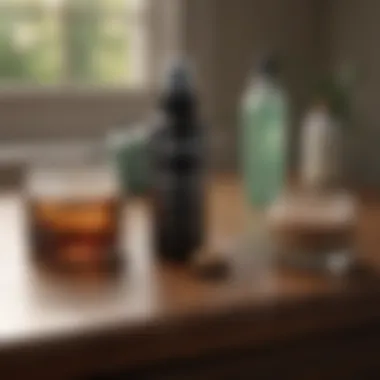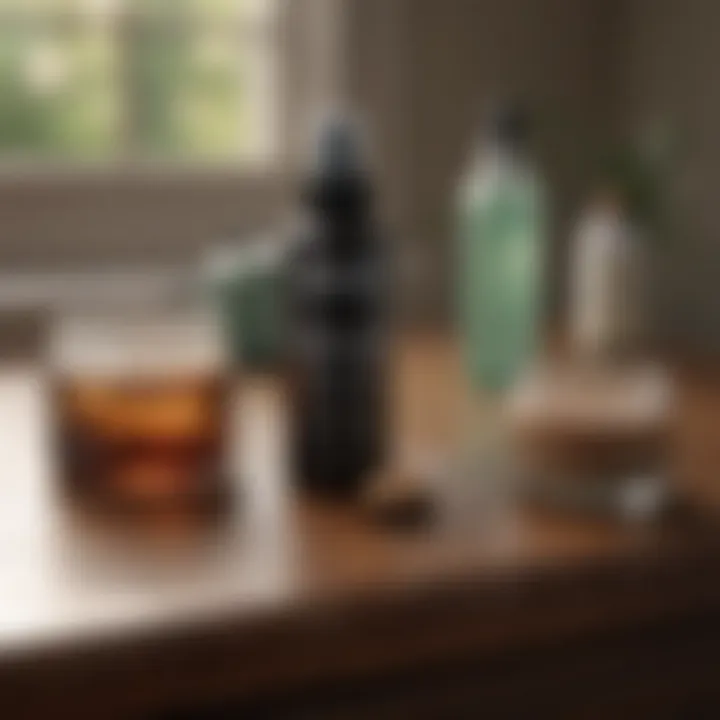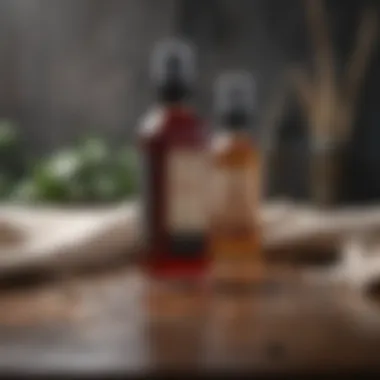Effective Ways to Remove Makeup Stains from Clothes


Intro
Makeup stains on clothing can be frustrating and, at times, seem impossible to erase completely. Many individuals regularly face this issue, especially those who are passionate about cosmetics or frequently attend events where makeup is essential. Understanding how to effectively remove these stubborn stains is crucial in giving garments a longer lifespan and maintaining their quality appearance.
This article delves into various methods for tackling makeup stains, emphasizing both do-it-yourself techniques and commercially available solutions. It also highlights essential fabric considerations and preventative measures to help avoid such stains in the future. By arming yourself with practical information, you can confidently manage makeup-related stains efficiently and effectively, thereby preserving your favorite clothing items.
Key Insights and Trends
Understanding the type of makeup products and their ingredients is essential for effective stain removal. Recent trends show that many cosmetics are now formulated with longer-lasting pigments and more complex bases, making them more durable -- but this also makes them harder to remove when they end up on fabric. Understanding the components of the makeup will assist in choosing the right removal method.
Makeup Composition
Makeup products vary widely in composition. Common items include foundations, lipsticks, and eye shadows.
- Foundations often consist of oils, water, and pigments.
- Lipsticks contain wax, oils, and colorants.
- Eye shadows may have a powder base and various binders.
The presence of oils and waxes in these products means that the approaches to removal must address these substances directly.
Shift Towards Natural Ingredients
There is a growing trend toward using natural ingredients in cosmetics. While they may be kinder to the skin, they can still pose a challenge when it comes to cleaning stains. This shift means that dedicated stain removers may need to adapt their compositions to handle these new formulations efficiently.
Practical Tips and How-To Guides
Initial Steps for Stain Treatment
When a makeup stain occurs, immediate action helps to reduce the damage.
- Do Not Rub: Rubbing can spread the stain, making it worse.
- Blot the Area: Use a clean cloth to gently blot the stain.
- Cold Water Rinse: Rinsing the stained area with cold water helps to dilute the makeup.
DIY Techniques
Several home remedies have proven effective in stain removal without the need for costly commercial products.
- Dish Soap and Water: Mix dish soap with water and apply to the stain. Blot gently and rinse.
- Baby Wipes: In a pinch, baby wipes can do a great job at lifting makeup stains, especially foundation and lipstick.
- Rubbing Alcohol: Dampen a cotton ball with rubbing alcohol and dab at the stain. Always test this technique on an inconspicuous area first to ensure fabric safety.
Commercial Solutions
Many products are available that target makeup stains specifically. Brands like OxiClean MaxForce and Shout Advanced Gel offer formulas designed to break down makeup ingredients effectively.
- Spot Cleaners: Look for non-toxic options that specify makeup removal for the best results.
- Laundry Detergent with Stain Fighters: Choose a detergent that includes enzymes for additional cleaning power.
"Equipping yourself with knowledge on makeup stain removal can save time and protect your clothing investment."
Preventative Measures
To minimize the risk of future makeup stains, consider these strategies:
- Use Protective Layers: Wearing an apron or using a cloth when applying makeup can cover your clothing.
- Select Transfer-Resistant Formulas: Opt for makeup products that boast long-wear and transfer-resistant properties.
- Regular Maintenance: Clean garments regularly to prevent buildup of makeup residue.
By understanding the nature of makeup stains and adopting a proactive approach, individuals can better manage the challenge of maintaining their clothing.
Learned techniques can be both practical and effective, ensuring that clothing looks pristine and vibrant over time.
Prelude
Makeup stains on clothing are a frequent headache for many individuals. Whether it’s a smudge from your favorite lipstick or a streak from foundation, these blemishes can be frustrating, particularly when they can ruin a cherished garment. Understanding how to effectively tackle these stains not only preserves your wardrobe but also enhances your overall confidence. In this article, we delve deeply into effective methods to remove makeup stains from clothing, presenting a range of solutions tailored to diverse situations.
A vital component to consider is the composition of makeup products. Different makeup types have varying ingredients that can influence the type and severity of the stain they produce. Properly understanding this can enable you to choose the right removal strategy. Dedicating time to learn efficient methods of stain removal, whether through household items or specialized products, can save you from bad moments and monetary losses.
Furthermore, knowing the appropriate immediate actions and long-term prevention strategies significantly minimizes the chances of stains occurring in the first place. By following the detailed steps outlined here, readers can master the art of makeup stain removal, ensuring their clothing remains in impeccable condition.
This comprehensive guide will equip homeowners, party hosts, and anyone keen on maintaining their wardrobe with the necessary knowledge to deal with makeup stains proactively and effectively. As such, the goal is to reduce frustration while preserving valuable garments.
Understanding Makeup Composition
Understanding the composition of makeup is crucial for effectively removing stains. Different makeup products have various ingredients that react differently with fabrics. Recognizing these differences allows for tailored stain removal strategies. This knowledge aids in identifying the best approach for treating stains, which can prevent fabric damage and ensure more successful outcomes.
Types of Makeup Products
Foundations
Foundations are a staple in many makeup routines. They create an even base, enhancing skin tone and texture. The primary characteristic of foundations is that they often contain oils or silicones, which contribute to their ability to provide coverage. This oil content can make foundations particularly challenging to remove from fabrics. The unique feature of foundations is their formulation, which can range from liquid to powder. Liquid foundations may leave behind more noticeable stains, while powder formulations may be easier to brush away.
Concealers
Concealers are designed to cover blemishes and dark circles. They are usually thicker than foundations, containing high levels of pigments. This property is beneficial for disguising imperfections but complicates stain removal. The mineral or wax-based formulations can make them ideal for long-wear applications. However, these characteristics often result in stubborn stains that require specific treatment to remove effectively.
Powders
Powders serve various purposes, including setting makeup and controlling shine. They are less likely to stain compared to liquids, but they can still leave marks, especially if they are heavily pigmented. The key characteristic of powders is their lightweight formulation, which typically helps absorb excess oil. Nevertheless, colored powders can pose a significant challenge if they become embedded in fabric fibers.
Blushes


Blushes add color to cheeks, enhancing one’s complexion. Most blushes are either powdered or cream-based. The specific aspect of blushes is their vibrant colors, which can lead to noticeable stains. While powder blushes may dust off easily, cream blushes can penetrate deep into the fabric. This means that different types of blush may require distinct removal techniques, depending on their formulation.
Lipsticks
Lipsticks are renowned for their long-lasting color, making them popular choices among users. Their key characteristic is a combination of waxes, oils, and pigments, resulting in a strong, durable finish. This durability poses challenges in stain removal. When lipstick stains occur, they often require specific solvents or cleaning solutions designed to break down these types of oils, which can be quite resistant to traditional methods.
Stain Formation Mechanism
Understanding how stains form is integral to developing effective removal strategies. Stains do not merely appear; they result from a chemical interaction between the makeup and the fabric.
Oil-based vs Water-based Stains
Oil-based stains are generally more challenging to remove than water-based stains. Oil-based products can penetrate fabric fibers and adhere firmly, leading to long-lasting marks. The key characteristic of these stains is their oiliness, which may require specialized solvents for removal. Water-based products, on the other hand, are easier to treat because they can often be removed with plain water or mild detergent. Knowing whether a stain is oil-based or water-based affects the choice of cleaning method.
Color Pigment Impact
Color pigments in makeup also play a significant role in stain formation. Highly pigmented products, like bright blushes or dark lipsticks, can leave vivid markings on clothes. These pigments can bind tightly to fibers, making them challenging to eliminate. The unique feature is that certain pigments are more resistant to fading than others, complicating removal efforts. Recognizing the impact of color pigments helps determine the urgency and method for treating a stain.
Immediate Actions to Take
When confronted with a makeup stain on clothing, the first steps are crucial for mitigating damage. Immediate actions can vastly improve the likelihood of complete stain removal. The longer a stain remains untreated, the more it sets into the fabric. Thus, understanding the process of stain assessment and blotting is vital in any effective stain removal strategy.
Assessing the Stain
Identifying Fabric Type
The fabric type plays a significant role in how a stain should be treated. Different fabrics have distinct properties that determine how they respond to water or cleaning agents. For example, cotton is generally durable and can withstand more aggressive treatments. However, delicate fabrics like silk require more cautious methods. The key characteristic of fabrics like silk is their sensitivity to moisture and certain chemicals, making them more prone to damage.
Understanding this aspect allows a user to select appropriate cleaning methods, reducing the risk of further complications. Identifying whether the garment is synthetic or natural fiber can influence the effectiveness of the chosen stain removal technique. While natural fibers may absorb stains more readily, synthetics may repel some substances, requiring different approaches.
Evaluating Stain Age
Evaluating the age of a stain is another critical factor. Fresh stains are typically easier to remove than older, set-in stains. The key characteristic of a recently formed stain is its surface presence, which allows for effective treatment without extensive soaking or scrubbing. When evaluating the stain age, it is essential to take note of color intensity and texture changes.
Older stains may require more intensive solutions or professional cleaning services. Moreover, age-related properties can inform the strategy to be employed. Waiting too long before treating a stain can lead to irreversible damage, making this evaluation particularly important in any stain removal plan.
Blotting Techniques
Using Paper Towels
One popular method involves using paper towels to blot the stain. This technique has its benefits due to the absorbent nature of these towels. Using paper towels allows for a quick response and helps contain the stain without spreading it further. This simplicity makes it a widely recommended choice in initial stain treatment steps.
The downsides include the potential for paper fibers to embed in the fabric if used too vigorously. Therefore, a gentle blotting motion is recommended to minimize this risk. Being disposable, paper towels offer practicality but may not provide the same level of softness as cloth alternatives.
Employing Cloths
Employing cloths can be another effective method for stain removal. The key advantage of using cloths is their ability to be reused, making them environmentally friendly. High-quality microfiber cloths can absorb liquids efficiently while being gentle on various fabrics. Their soft texture reduces the risk of fabric damage compared to rougher materials.
However, care should be taken to ensure that the cloth is free of any interfering substances, such as laundry detergent residues from previous uses. This could result in additional staining. Overall, cloths provide a versatile option that blends convenience with effectiveness in the initial attempts to treat stains.
DIY Stain Removal Techniques
DIY stain removal techniques offer practical solutions for those who encounter makeup stains on clothing. These techniques utilize common household items that many people already have, providing immediate and cost-effective options for removing stubborn stains. By choosing DIY methods, individuals can often avoid the need for harsh chemicals, making them a safer choice for the environment and personal health. Understanding these methods can empower homeowners and party hosts, allowing them to act swiftly when accidents happen.
Common Household Items
Baking Soda
Baking soda is a versatile agent that can play a significant role in stain removal. Its abrasive texture helps to lift stains without damaging fabric. One of its key characteristics is its ability to absorb odors, making it a dual-purpose remedy. Users can create a paste by mixing baking soda with water, then applying it directly to the stained area. The unique feature of baking soda is its mild alkalinity, which can break down oils and pigments in makeup. However, it may not tackle all stains effectively, especially older ones, thus requiring multiple applications.
Vinegar
Vinegar is another favored household item for DIY stain removal. Its acidity helps dissolve the components of makeup stains, making it easier to treat fabrics. This versatile ingredient serves as a gentle and effective cleaner. Users often mix vinegar with water for a less harsh solution that is still quite effective. The unique advantage of vinegar is its ability to maneuver into the fabric fibers, breaking down the stain at the source. Nevertheless, vinegar's strong scent can be off-putting for some, which may lead to hesitation in its use.
Dish Soap
Dish soap is well-known for its grease-cutting properties, which can make it particularly useful for makeup stains. Its surfactant properties help to lift and emulsify oils from the fabric. When mixed with water, dish soap forms a solution that can break down stubborn stains effectively. This makes it a popular choice in many households. The unique aspect of dish soap is its ability to penetrate deep into fabric fibers. However, it is important to rinse thoroughly, as soap residue can cause irritation to the skin or lead to additional staining.
Spot Cleaning Methods
Spot cleaning methods focus on treating stains directly rather than immersing the entire garment in water or cleaning solution. This approach is often more effective for makeup stains, which can be localized. By addressing stains at the source, you can minimize potential damage to the fabric.
Mixing Solutions
Mixing solutions for spot cleaning can enhance the effectiveness of stain removal. The process typically involves combining different household items to create a powerful cleaning solution. For instance, mixing dish soap and vinegar can yield a potent formula. The key advantage of mixing solutions is flexibility; you can adjust concentrations based on the severity of the stain. However, it’s essential to test any new mixture on a small, inconspicuous area first to ensure fabric safety.
Application Techniques
Application techniques play a critical role in effective stain removal. It involves applying the cleaning solution in a specific manner that maximizes adhesion to the stain without damaging the fabric. Gentle dabbing and blotting are preferable methods. The unique characteristic of these techniques is that they limit the spread of the stain and additional damage to the cloth. Proper application ensures that the cleaning solution can work effectively without causing more harm. However, one must avoid rubbing too hard, as it may worsen the situation by pushing the stain further into the fibers.
Commercial Stain Removers


Commercial stain removers play a significant role in effectively tackling makeup stains on clothing. They offer specialized formulations designed to penetrate various types of stains, making them particularly effective when time is of the essence. With a wide range of options available, these products serve as a convenient choice for individuals who may not have the time or resources to pursue DIY methods. Understanding the different types of commercial stain removers, as well as how to select the right one, can enhance the chances of successfully removing stains without damaging the fabric.
Types of Stain Removers
Pre-treatments
Pre-treatments are a critical element in the stain removal process. Their main contribution lies in their ability to break down stubborn stains before the garment is washed. A key characteristic of pre-treatments is their targeted approach; they often contain enzymes or surfactants that specifically target makeup components such as oils and pigments. This makes them a popular choice for those who wish to maximize the chances of successful stain removal.
However, it is essential to apply pre-treatments correctly. Generally, they should be applied directly to the stain and allowed to sit for a specified amount of time before laundering. One unique feature of pre-treatments is their versatility; they can often be used on various fabric types, which adds to their advantage. On the downside, some pre-treatments may interact poorly with certain delicate fabrics, making careful usage necessary.
Stain Removal Wipes
Stain removal wipes are another convenient option available in many households. They are particularly useful for quick fixes on-the-go, especially during events or outings. A significant advantage of stain removal wipes is their portability; they fit easily in bags or purses, allowing immediate stain care. Typically pre-moistened, these wipes can help lift makeup stains effectively shortly after contact, which is essential in preventing the stain from setting.
Despite their benefits, one must be cautious when using them. The unique feature of these wipes is their disposable nature, meaning they are designed for single use. This can lead to increased waste compared to other stain removal solutions. Furthermore, over-reliance on wipes might not be the most effective strategy for tougher stains, requiring additional treatment afterward.
How to Choose the Right Product
Choosing the right stain remover is pivotal for effective stain management. An informed decision ensures the selected product aligns with the specific stain type and fabric.
Reading Labels
Reading labels is an essential step when selecting a stain remover. Labels provide vital information about the product’s intended use and effectiveness against specific stains. A key characteristic of labels is that they often include instructions for proper application and any necessary precautions. This knowledge is crucial for guiding users in their stain removal efforts.
When paying attention to labels, one can avoid potential damage to their fabrics and increase the likelihood of effective stain removal. Specific indications on labels about fabric compatibility or stain types can highlight whether a product will be suitable. However, some labels may have ambiguous wording, making it challenging for consumers to discern a product's effectiveness at a glance.
Understanding Ingredients
Understanding ingredients can significantly impact the effectiveness of stain removal. Knowing what comprises a stain remover allows users to make informed decisions based on their specific needs. A key characteristic of ingredients is their function; for example, surfactants aid in loosening the stain, while enzyme-based treatments target specific components within the makeup.
Being aware of the ingredients can help users avoid potential allergens or harsh chemicals, making it a beneficial approach for sensitive skin or fabrics. Some unique features, such as eco-friendly components or non-toxic formulations, can attract environmentally-conscious consumers. On the other hand, complex ingredient lists can be daunting, which may lead some individuals to overlook critical information that could influence their choice.
Prevention Strategies
Preventing makeup stains on clothing is crucial for maintaining the integrity of your garments. A proactive approach can save time and effort associated with stain removal. Understanding how to choose makeup wisely and adopt protective measures can significantly reduce the chances of stains occurring.
Choosing Makeup Wisely
Waterproof vs Non-Waterproof
Choosing between waterproof and non-waterproof makeup is not merely about preference; it can impact future stain challenges. Waterproof products, as the name suggests, are designed to resist moisture. This prevents smudging and fading during wet conditions, but it also means that, if they do stain, removal is harder. The key characteristic of waterproof makeup is its ingredient composition, which often includes oils and heavy waxes that bond strongly to the skin. When these products come into contact with fabric, their durability can translate to stubborn stains.
Waterproof makeup can be beneficial for occasions when you need longevity. However, it can pose a disadvantage since many traditional stain removers may struggle to break down the oils within these products.
Non-Comedogenic Formulas
Non-comedogenic products are formulated not to clog pores. This characteristic makes them appealing to many consumers, particularly those concerned with acne. For makeup wearers, selecting non-comedogenic options means decreased risk of skin irritation. However, while this formula carries benefits for skin health, it might not always be the best choice for fabric. Non-comedogenic makeup can still transfer to clothing but is generally formulated to be less oily.
The unique feature of non-comedogenic formulas lies in their lighter consistency. They can provide decent color coverage while minimizing the contact with fabric. Though they do not guarantee a complete avoidance of stains, their lower oil content can yield easier cleanup if there is an accident.
Protective Measures
Using Cover-ups
Using cover-ups can be an effective strategy to protect clothing while applying makeup. Cover-ups are typically designed to shield your clothing from products that contain oils and pigments. These products can vary from fabric-like drapes to specialized clothing protectors. The key characteristic of using cover-ups is they act as a barrier, preventing makeup from getting onto fabric.
The benefit of using cover-ups is clear: they protect clothes without sacrificing the makeup application process. Their major advantage is delivery, as they allow you to focus on applying makeup without concern for potential stains.
Wearing Aprons
Wearing aprons while applying makeup represents another layer of prevention. This simple garment covers the upper part of the body and can be easily washed. The key characteristic of an apron is its practicality, designed for ease of wear and removal.
Aprons are particularly beneficial for those who may frequently make mistakes while applying makeup. They not only reduce stain risks but also keep your outfit neat. One disadvantage could be the style factor; some may not prefer wearing additional clothing items. However, the benefits of preventing stains typically outweigh these aesthetic concerns.
Overall, both choosing makeup wisely and employing protective measures can substantially minimize the chance of makeup stains on clothing.
Specific Fabric Considerations
Understanding how different fabrics react to makeup stains is essential. Each type of material has unique properties that can influence the ease of stain removal. By identifying the fabric type, one can choose appropriate cleaning techniques that minimize damage while effectively addressing the stain. Knowledge of fabric characteristics also aids in selecting prevention strategies to protect garments from future makeup mishaps.
Removing Stains from Delicate Fabrics
Satin
Satin is often chosen for its luxurious feel and elegant appearance. It is typically made from silk or synthetic fibers that create a smooth surface. This fabric is prone to staining due to its glossy finish, which can show marks easily. One key characteristic of satin is its susceptibility to water damage. When addressing makeup stains, it is important to consider a gentle approach. Using harsh chemicals or excessive rubbing can ruin the fabric's sheen.
The unique feature of satin is its ability to absorb stains thoroughly, which can be a disadvantage. Immediate action is vital. If a satin garment gets stained, one should avoid using hot water. Instead, cold water along with a mild detergent will do. This method helps to preserve the satin's texture while effectively lifting the stain.
Linen
Linen is known for its breathability and natural fibers, which make it a popular choice for warm-weather garments. The fabric has a textured surface that can trap particles, including pigments from makeup. A key characteristic of linen is its durability; however, it tends to wrinkle easily.


Regarding stain removal, linen is a bit more forgiving than satin. The unique feature of linen is its resilience against heat and abrasion. This quality means that when attempting to remove stains, one can use higher water temperatures, as long as the care label permits it. A paste of baking soda and water can be an effective way to treat makeup stains on linen. This not only lifts the stain but also can help keep the fabric looking fresh.
Removing Stains from Durable Fabrics
Cotton
Cotton is ubiquitous in garments today due to its comfort and versatility. One striking aspect of cotton is its absorbency; it can easily soak up liquids, making it prone to stains. However, this characteristic also means that cotton is relatively easy to clean.
Cotton can generally withstand higher temperatures, making it suitable for using a variety of stain removal solutions. A key advantage of cotton is its ability to endure rigorous washing, which is beneficial for removing stubborn makeup stains. Pre-treating cotton with a stain remover before laundering can yield excellent results.
Polyester
Polyester is often appreciated for its durability and resistance to wrinkling. This synthetic fabric has a smooth surface that does not easily absorb stains, which can be advantageous in a makeup context. The key feature of polyester is its strength; it can withstand vigorous cleaning without losing its shape or color.
While polyester is resilient, it can sometimes repel water, which complicates stain removal. One downside is that when makeup is left too long on polyester, it can set deeply. For effective stain removal, a mixture of dish soap and white vinegar can effectively lift makeup stains. Applying this solution before washing helps ensure that the fabric retains its integrity while minimizing makeup-related damage.
Post-Stain Removal Care
Post-stain removal care is a critical aspect in maintaining the integrity of your clothing after handling makeup-related stains. Once the initial cleaning has been completed, careful post-treatment can enhance the garment's longevity while preventing further damage. It ensures that the fabric remains intact and the color does not fade. This section will focus on two main components: washing techniques and drying methods.
Washing Techniques
Temperature Considerations
When it comes to washing stained clothing, temperature considerations are crucial. Different fabrics react differently to heat. For instance, higher temperatures may effectively break down makeup residues, but they can also set the stain if used improperly. Choosing the right temperature must depend on the fabric type and stain age.
Washing in hot water can be beneficial for durable materials like cotton, helping to dissolve oil-based stains. On the other hand, delicate fabrics require cooler temperatures to prevent damage. The unique feature of temperature considerations is finding a balance between effectiveness and fabric care. Overheating can shrink or distort your garments. Therefore, it is important to refer to the garment care label as a guide, ensuring no adverse effects occur during the washing process.
Detergent Selection
Detergent selection plays a fundamental role in effectively removing makeup stains. The right detergent not only helps dissolve the makeup but can also contribute to maintaining the fabric's texture and color. It is crucial to choose a detergent that caters to the specific type of stain you are dealing with. For example, enzyme-based detergents are highly effective against protein-based stains.
A key characteristic of effective detergents is their ability to penetrate fabric fibers without causing harm. They are designed to lift stains while preserving the quality of the material. A unique feature of detergent selection is its role in different washing cycles. Certain detergents work better in specific cycles, which can enhance the stain removal process. However, it is essential to avoid using excessive amounts of detergent as it may leave residues that irritate the skin and require additional rinsing.
Drying Methods
Avoiding Heat
Avoiding heat is an essential method when drying post-stain treated clothing. Heat can shrink fabrics and cause permanent damage, especially when it comes to delicate items. Letting garments air dry helps them maintain their shape and texture. Additionally, avoiding heat prevents any remaining makeup residue from setting into the fabric.
The key characteristic of this method is its gentleness on a wide range of fabrics. In general, air drying is a popular choice as it allows the material to breathe, reducing the chances of a musty smell or mildew formation. This method is especially beneficial for sensitive fabrics where heat exposure could lead to irreversible harm.
Air Drying Best Practices
Air drying best practices take a significant role in effective garment care. This method should always be preferred, especially after stain removal efforts. Hanging clothes in a well-ventilated area not only preserves the fabric but also allows any remaining moisture to evaporate naturally. If possible, lay flat items that may lose their shape when hung up.
A valuable aspect of air drying is how it permits the garment to recover from any stress induced during washing. This slow and gentle drying process helps fabrics maintain their structure and color. However, an important consideration is to ensure items are not exposed to direct sunlight for prolonged periods, as this can lead to fading over time.
Post-stain removal care can often determine the garment's long-term durability and appearance. Investing time in the right techniques yields significant benefits.
Professional Cleaning Services
When dealing with makeup stains on clothing, professional cleaning services can be a worthwhile consideration. These services offer solutions for stains that are particularly stubborn or when home remedies fail to deliver the desired results. They provide expertise and specialized techniques that may be required for effective stain removal. Understanding when to seek professional help is essential in preserving clothing and ensuring that stains are dealt with promptly and correctly.
When to Seek Professional Help
Severe Stains
Severe stains present unique challenges that often exceed typical home cleaning capabilities. Makeup can be deeply set, especially if not treated immediately. The key characteristic of severe stains is that they often require more than just surface cleaning; they may need pre-treatments or other specialized processes for effective removal.
By seeking professional help for these challenging stains, you increase the likelihood of restoring the garment to its original condition. Professionals can employ advanced stain removal techniques that are not accessible to an average homeowner. The unique feature of these severe stains lies in their complex composition, combining various product types and pigmentations, which can lead to permanent damage if mishandled. The advantage of addressing severe stains with professionals is the assurance of proper care and specific treatment plans tailored to the fabric and stain type.
Luxury Fabrics
Luxury fabrics such as silk, cashmere, or high-end blends warrant professional cleaning services due to their delicate nature. The key characteristic of luxury fabrics is their sensitivity to harsh chemicals and vigorous scrubbing. These fabrics can be easily damaged by improper handling, making knowledge of material properties essential. For this reason, professional services become a beneficial choice when dealing with makeup stains on such garments.
Luxury fabrics often require specialized products and techniques that are finely tuned to their specific needs. The unique feature of these fabrics is their texture and structure, which can absorb stains differently compared to more durable fabrics. Utilizing professional services ensures that your expensive clothing is treated correctly, maintaining its integrity and appearance over time. The downside of not using professional help for such delicate items can lead to irreversible damage, resulting in high costs for replacement.
How to Choose a Service
Choosing the right professional cleaning service requires careful consideration. Not all services maintain the same standards, so it’s essential to evaluate certain criteria.
Reputation
Reputation plays a significant role in how effective a cleaning service may be. A company with strong positive reviews often indicates reliability and skill in various cleaning methods. The key characteristic of a well-regarded service is consistency in quality and customer satisfaction. Their reputation can be seen as a reflection of their effectiveness in removing tough stains, including those caused by makeup. When you select a service based on reputation, you usually gain the assurance that you are entrusting your garments to capable hands. However, there can be a disadvantage to reputation-based choices—high demand can sometimes lead to longer wait times, particularly for in-demand services.
Services Offered
Understanding the range of services offered by a cleaning company is essential. Different stains and fabrics require specific methods for effective treatment. A benefit of choosing a service that provides a comprehensive array of cleaning options is the flexibility in addressing various needs. The offerings may include everything from basic washing to specialized stain removal processes tailored for unique materials. The unique aspect of broad service availability is that clients can find a singular solution for multiple types of garments and issues. However, services that are too broad may lack specialization in certain areas, potentially compromising effectiveness on specific stains or fabrics.
The End
The primary benefits of knowing how to remove these stains are twofold: preservation of clothing and maintenance of aesthetics. Makeup stains not only impact the appearance of clothing but can also lead to a sense of frustration when trying to maintain a polished look. Being equipped with effective removal techniques allows individuals to act confidently and efficiently. This knowledge empowers them to address any mishaps that arise during daily routines or special events.
Considerations for proper stain removal go beyond just the immediate action. They encompass an understanding of different fabric types, which influences the choice of cleaning technique. For instance, delicate fabrics require more gentle approaches, while durable materials can withstand harsher treatments. This factor cannot be underestimated when selecting a working solution.
Additionally, the article highlights the importance of preventive measures. By understanding the composition of makeup products and choosing wisely, readers can minimize the risk of stains on their clothing. Moreover, wearing protective gear, such as aprons or cover-ups, adds another layer of security against potential damage.
Ultimately, the exploration of both DIY strategies and commercial solutions ensures readers have multiple options at their disposal. From using common household items like baking soda and vinegar to considering professional services for severe stains, a well-rounded understanding of the topic equips individuals with practical skills to tackle challenging stains.
In essence, mastering effective makeup stain removal techniques enhances both the longevity of garments and the overall confidence of individuals in their wardrobe choices. A proactive approach fosters not only maintenance but also a nurturing relationship with one's clothing.



